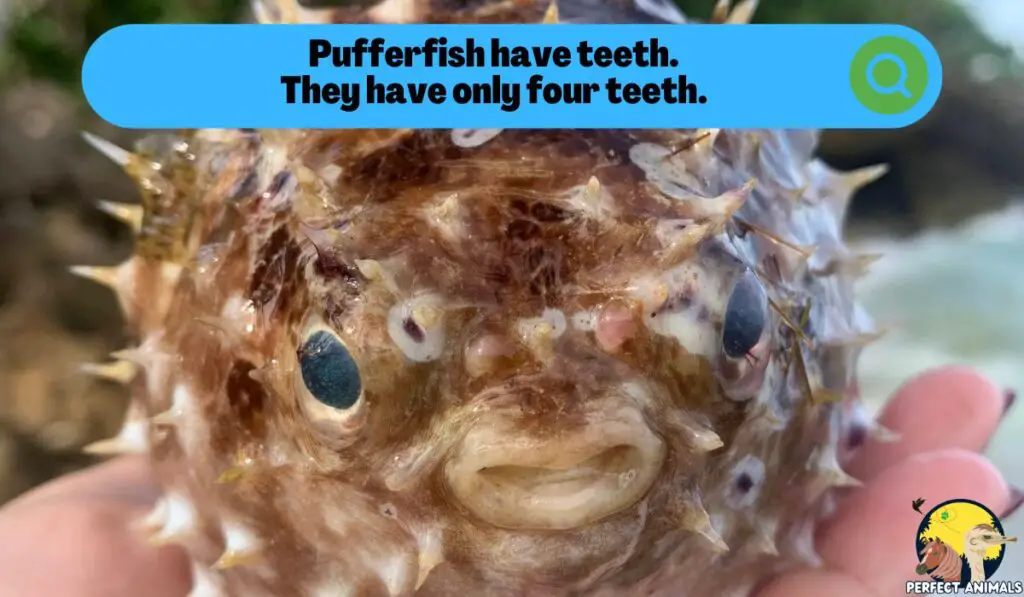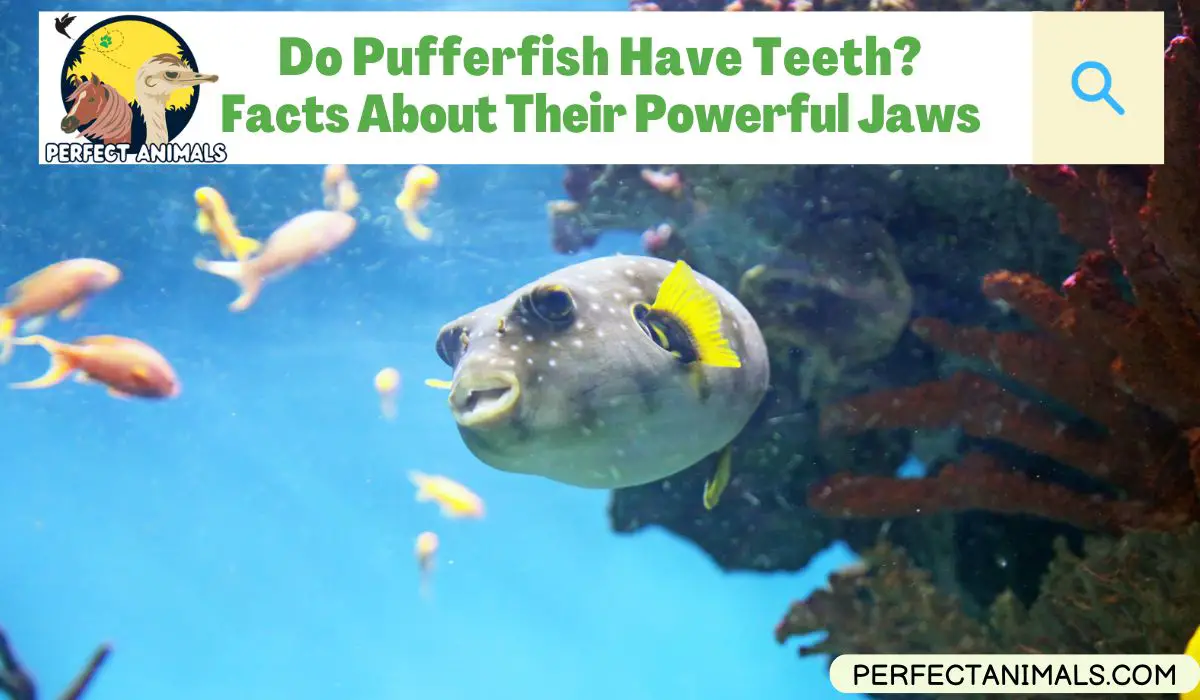With their round, puffy bodies and big eyes, pufferfish look like floating balloons with fins.
But behind their cute exterior lies a formidable bite. Pufferfish have a mouth structure that allows them to pack quite a wallop for a fish of their size.
This leads to an interesting question – do pufferfish actually have teeth?
In this article, we’ll explore the tooth anatomy of these unique aquatic animals.
We’ll examine if pufferfish have teeth in both their freshwater and saltwater varieties.
We’ll also touch on how strong their bites can be and some of their unusual feeding behaviors.
you’ll learn some cool facts about their chompers.
Let’s dive in and learn the truth about pufferfish!
Do Pufferfish Have Teeth?
Yes, pufferfish do have teeth. However, their teeth are quite different than human chompers or even the teeth of many other fish.

Pufferfish teeth are not individual pearly whites like we have. Rather, they possess a beak-like structure made up of four strong dental plates that are fused together.
It’s formed from the same dentine material as regular fish teeth, just consolidated into one solid mass per jaw.
This beak contains teeth that continuously grow throughout a pufferfish’s lifetime.
The teeth don’t have roots like ours do – they are attached to the jawbone in a way that enables perpetual replacement of worn teeth with new ones.
Powerful jaw muscles surround the pufferfish’s toothy beak, enabling it to deliver forceful bites and grind up hard-shelled prey like crabs, mollusks, and shellfish.
Their continuously growing and regenerating teeth are important since they erode from this tough diet.
Hard foods help naturally trim their ever-growing teeth.
Related Article – Do Turtles Have Teeth?
How Many Teeth Does a Pufferfish Have?
Pufferfish don’t have a mouthful of individual teeth like humans – instead, they have just four total teeth that are fused together into a unique beak structure.
These four teeth consist of an upper and lower set.
The two teeth on the top join together as one solid dental plate. The two teeth on the pufferfish’s lower jaw also fuse into a single sturdy triangular tooth.
This gives pufferfish what looks like just one giant tooth on the top and bottom.
But it’s actually two teeth in each that have melded together over time into a single beak-like unit per jaw.
Having just four total teeth allows pufferfish to generate incredible bite forces.
Their simple yet effective dental structure concentrates all the strength of their jaw muscles into two fused tooth units top and bottom.
Do Freshwater Pufferfish Have Teeth?
Freshwater pufferfish also have continuously growing teeth, just like their saltwater relatives.
Their distinctive beak structure forged from fused teeth is adapted for crunching up hard-shelled foods.
In the wild, freshwater pufferfish dine on snails, shellfish, and other foods that help naturally grind down their ever-growing teeth.
But pufferfish living in aquariums or kept as pets often don’t get the same abrasive diet.
Without enough hard, crunchy foods, the teeth of captive freshwater pufferfish can overgrow over time.
Since their teeth are constantly regenerating, they can sometimes grow faster than they wear down without the coarse diet they’d have in nature.
Overgrown teeth prevent pufferfish from opening their mouths wide enough to eat properly. This can become a dangerous issue that prevents the fish from feeding itself.
For freshwater pufferfish owners, it’s important to regularly offer foods with shells and crunchy bits to help trim their teeth.
Snails, crayfish, and certain fish foods can help. However, some overgrown pufferfish teeth require filing by a qualified veterinarian to shorten them while the fish is safely sedated.
Proper dental care is essential for freshwater pufferfish in captivity to ensure their unique teeth stay functional and don’t overgrow uncomfortably.
Their interesting tooth anatomy requires attentive dental maintenance.
You May Also Like – Do Barracudas Eat Fish Eggs?
Can a Pufferfish Bite?
Pufferfish may look cute and harmless floating around an aquarium, but they can definitely bite!
In the wild, pufferfish use their powerful jaws and fused tooth beaks to crush and grind up prey with hard shells. This beak is integral to their ability to feed on crunchy foods that erode their continuously growing teeth.
Even small pufferfish have very strong bite forces for their size. All that strength concentrated into their beak-like mouths allows them to clamp down and deliver painful bites.
Pufferfish don’t have hands or claws to explore their environments. They often use their mouths to investigate objects.
This tendency means pufferfish in captivity will sometimes mistakenly bite their owners.
While not designed to bite humans, aquarium pufferfish can give a decent nip with their durable tooth breaks. Their jaws are incredibly tough and designed for pulverizing thick shells.
A nip from a pufferfish in your tank is sure to catch you by surprise!
Pufferfish bites don’t often break the skin. But they can leave a mark and radiate pain. The bony plates form their toothy beak concentrating all their force into a small pointy surface.
So while they may look harmless, pufferfish have bite abilities worthy of their fearsome reputation.
Their unique mouths allow them to crunch through shells and deliver surprisingly strong clamps even on human hands that get too close!
You May Also Like – Do Fish Blink? Fact or Fiction?
Do Pufferfish Swallow Water?
The pufferfish’s unique ability to swallow huge amounts of water to balloon up and appear larger is one of its most fascinating defenses.
But do pufferfish actually gulp and swallow water into their stomachs when they puff up?
The answer is no – pufferfish don’t swallow water directly into their bellies and digestive systems when inflating. Instead, they have specially adapted stomachs and skin to expand their bodies rapidly with water.
Pufferfish have elastic stomachs that can distend and increase in size very quickly.
But the stomach stays sealed off and closed when they puff up. The water doesn’t enter their gastric systems.
Along with an expandable stomach, pufferfish skin is also highly elastic and able to stretch.
It has specialized crosslinking collagen that enables to it balloon out as they intake water.
The water gets pulled in through their mouth and pumped throughout their body extremely fast via vascular control.
But it is contained in elastic cavities between skin layers and around organs rather than being swallowed into the digestive tract.
So while it appears as if they are gulping down water, pufferfish are actually inflating discreet cavities throughout their body when threatened.
Their expandable stomachs and skin allow them to efficiently pump in water and puff up without harming themselves by ingesting it directly.
A pretty clever trick for scaring off predators!
You May Also Like – Do Orcas Eat Polar Bears?
Final Thoughts
Pufferfish have some of the most unique dental equipment in the ocean – fused beaks of just four total teeth designed for crunching hard-shelled prey.
Their intriguing tooth structure certainly lives up to their fearsome reputation.
We learned pufferfish teeth are different than most fish, continuously growing and regenerating to form durable beak-like plates.
Both freshwater and marine pufferfish share this odd arrangement of just four fused teeth.
Their powerful jaws and concentrated bite force paired with their hardy beaks allow pufferfish to clamp down on crustaceans and mollusks, grinding up calcium carbonate shells.
This abrasive diet necessitates never-ending tooth growth.
Proper dental care for pet pufferfish prevents overgrown teeth since their natural diet provides important grinding. And floating around the aquarium, they may look cute but can still nip fingers that get too close!
Pufferfish have specially adapted with their unique chompers to thrive dining on crunchy shellfish.
Their four fused teeth may be few in number but pack a serious bite!
Resources – (for further reading)
National Geographic – Pufferfish
Britannica – Puffer | Freshwater, Aquarium, Care
ScienceDirect – Puffer Fish – an overview

Sofi has worked as an educator at the Miami Seaquarium, where she conducted educational programs about marine life. In her free time, she contributes to our platform, sharing her passion for marine ecosystems and their conservation.

